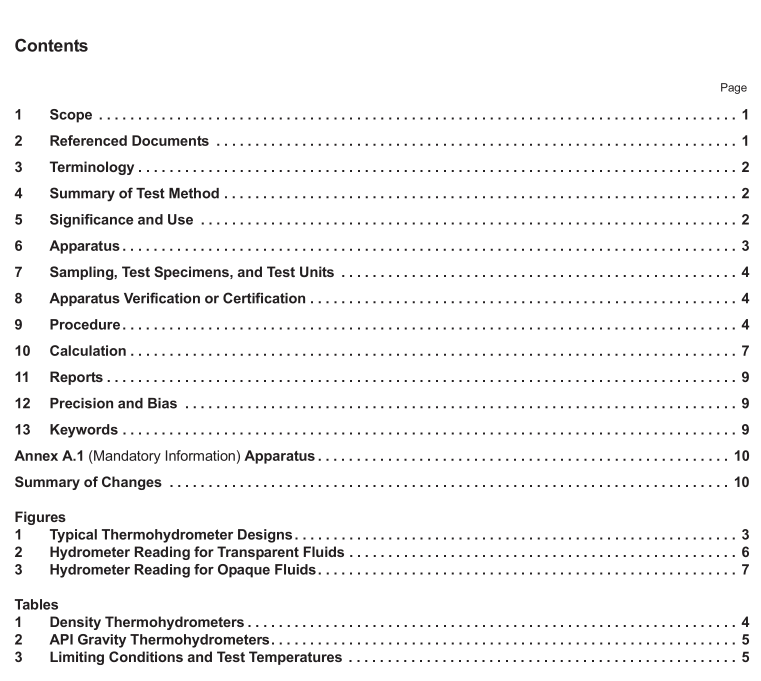API MPMS 9.3 pdf download

API MPMS 9.3 pdf download Manual of Petroleum Measurement Standards Chapter 9.3 Standard Test Method for Density, Relative Density, and API Gravity of Crude Petroleum and Liquid Petroleum Products by Thermohydrometer Method
Summary of Test Method
4.1 The density or API gravity, after temperature equilib- rium has been reached, is read by observing the freely floating thermohydrometer and noting the graduation nearest to the apparent intersection of the horizontal plane surface of the liquid with the vertical scale of the hydrometer after temperature equilibrium has been reached. The observed thermohy- drometer reading is reduced to the reference temperature value by means of the Petroleum Measurement Tables (the appropriate adjunct to Adjunct to D1250 Guide for Petroleum Mea- surement Tables (API MPMS Chapter 11.1) and observed temperature from the enclosed thermometer.
5. Significance and Use
5.1 Density and API gravity are used in custody transfer quantity calculations and to satisfy transportation, storage, and regulatory requirements. Accurate determination of density or API gravity of crude petroleum and liquid petroleum products is necessary for the conversion of measured volumes to volumes at the standard temperatures of 15°C or 60°F.
5.2 Density andAPI gravity are also factors that indicate the quality of crude petroleum. Crude petroleum prices are fre- quently posted against values in kg/m 3 or in degrees API. However, this property of petroleum is an uncertain indication of its quality unless correlated with other properties.
5.3 Field of Application—Because the thermohydrometer incorporates both the hydrometer and thermometer in one device, it is more applicable in field operations for determining density or API gravity of crude petroleum and other liquid petroleum products.
The procedure is convenient for gathering main trunk pipelines and other field applications where limited laboratory facilities are available. The thermohydrometer method may have limitations in some petroleum density determinations. When this is the case, other methods such as Test Method D1298 (API MPMS Chapter 9.1) may be used.
5.4 This procedure is suitable for determining the density, relative density, or API gravity of low viscosity, transparent or opaque liquids, or both. This procedure, when used for opaque liquids, requires the use of a meniscus correction (see 9.2). Additionally for both transparent and opaque fluids the read- ings shall be corrected for the thermal glass expansion effect and alternate calibration temperature effects before correcting to the reference temperature. This procedure can also be used for viscous liquids by allowing sufficient time for the thermo- hydrometer to reach temperature equilibrium.
6. Apparatus
6.1 Glass Thermohydrometers, as specified in Specification E100 (shown in Fig. 1), and graduated in:
6.1.1 Kilograms/cubic metre (kg/m 3 ) and degrees Celsius for density hydrometers, as shown in Table 1.
6.1.2 Degrees API (°API) and degrees Fahrenheit for hy- drometers measuring in API Gravity, as shown in Table 2.
6.1.3 The user should ascertain that the instruments used for this procedure conform to the requirements set out above with respect to materials, dimensions, and scale errors.
In cases where the instrument is provided with a calibration certificate issued by a recognized standardizing body, the instrument is classed as certified and the appropriate corrections for the meniscus effect, the thermal glass expansion effect, and alternative calibration temperature effects shall be applied to the observed readings prior to corrections. Instruments that satisfy the requirements of this test method, but are not provided with a recognized calibration certificate, are classed as uncertified and the appropriate corrections for the meniscus effect, the thermal glass expansion effect, and alternative calibration temperature effects shall be applied to the observed readings prior to corrections.
6.2 Hydrometer Cylinders, clear glass, plastic, or metal. For convenience of pouring, the cylinder may have a pouring lip. The inside diameter shall be at least 25 mm (1 in.) greater than the outside diameter ofthe thermohydrometer used. The height of the cylinder shall be such that the bottom of the thermohy- drometer clears the bottom of the cylinder by at least 25 mm (1 in.) when suspended in the sample test portion.
6.2.1 For field testing, a sample thief of suitable dimensions may be more convenient than a hydrometer cylinder. The liquid level shall be level with the top of the thief.
6.3 Temperature Bath, to control temperature close to the bulk hydrocarbon temperature or to control temperature close to the reference temperature of 15°C or 60°F.









